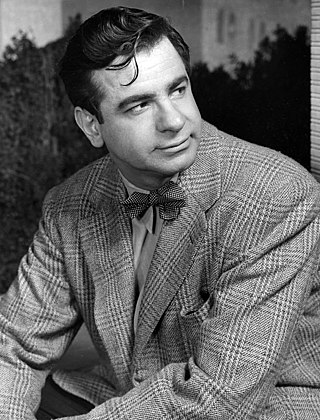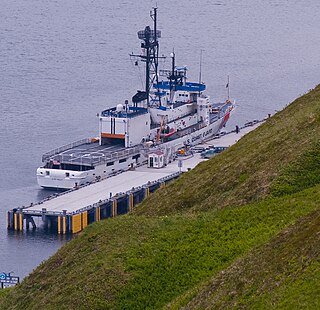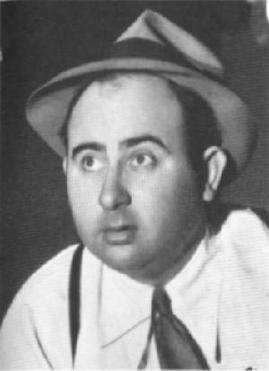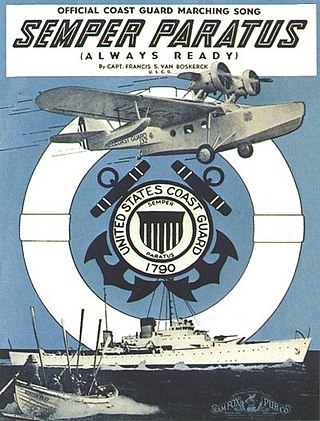
The United States Coast Guard (USCG) is the maritime security, search and rescue, and law enforcement service branch of the United States Armed Forces and one of the country's eight uniformed services. The service is a maritime, military, multi-mission service unique among the United States military branches for having a maritime law enforcement mission with jurisdiction in both domestic and international waters and a federal regulatory agency mission as part of its duties. It is the largest coast guard in the world, rivaling the capabilities and size of most navies.

Walter Matthau was an American actor, comedian and film director.

USCGC Alex Haley (WMEC-39) is a United States Coast Guard Cutter and former United States Navy vessel that was recommissioned for Coast Guard duty on 10 July 1999. It was first entered service as USS Edenton (ATS-1), an Edenton-class salvage and rescue ship on 23 January 1971. In 1995, Edenton won the Marjorie Sterrett Battleship Fund Award for the Atlantic Fleet.

USCGC Mesquite (WAGL/WLB-305) was the lead ship in the Mesquite class of seagoing buoy tenders operated by the United States Coast Guard. She served in the Pacific during World War II, and spent the rest of her Coast Guard career in the Great Lakes. She ran aground and was wrecked in December 1989 off the Keweenaw Peninsula in Lake Superior. She was scuttled nearby as a recreational diving attraction.

Joseph Francis Farley served as the ninth Commandant of the United States Coast Guard from 1946 to 1949. He was also the first Coast Guard officer to be issued a service number and held #1000 on the Coast Guard officer rolls.

Norman Rae Taurog was an American film director and screenwriter. From 1920 to 1968, Taurog directed 180 films. At the age of 32, he received the Academy Award for Best Director for Skippy (1931). He is the second youngest person ever to win the award after Damien Chazelle, who won for La La Land in 2017. He was later nominated for Best Director for the film Boys Town (1938). He directed some of the best-known actors of the twentieth century, including his nephew Jackie Cooper, Spencer Tracy, Mickey Rooney, Judy Garland, Deanna Durbin, Fred Astaire, Gene Kelly, Deborah Kerr, Peter Lawford, Dean Martin, Jerry Lewis, and Elvis Presley. Taurog directed six Martin and Lewis films, and nine Elvis Presley films, more than any other director.

The USCGC Bibb (WPG-31) was a 327-foot (100 m) Secretary-Class Coast Guard ship commissioned in 1936. Seven similar "combat cutters" were built and named for secretaries of the United States Treasury. Bibb was named for U.S. Secretary of the Treasury George M. Bibb.

"Semper Paratus" is a 1928 song and the official march of the United States Coast Guard, having been composed in 1927 by U.S. Coast Guard Captain Francis Saltus Van Boskerck.
The history of the United States Coast Guard goes back to the United States Revenue Cutter Service, which was founded on 4 August 1790 as part of the Department of the Treasury. The Revenue Cutter Service and the United States Life-Saving Service were merged to become the Coast Guard per 14 U.S.C. § 1 which states: "The Coast Guard as established January 28, 1915, shall be a military service and a branch of the armed forces of the United States at all times." In 1939, the United States Lighthouse Service was merged into the Coast Guard. The Coast Guard itself was moved to the Department of Transportation in 1967, and on 1 March 2003 it became part of the Department of Homeland Security. However, under 14 U.S.C. § 3 as amended by section 211 of the Coast Guard and Maritime Transportation Act of 2006, upon the declaration of war and when Congress so directs in the declaration, or when the President directs, the Coast Guard operates as a service in the Department of the Navy.

USCGC Yamacraw (WARC-333) was a United States Coast Guard Cable Repair Ship. The ship was built for the Army Mine Planter Service as U. S. Army Mine Planter Maj. Gen. Arthur Murray (MP-9) delivered December 1942. On 2 January 1945 the ship was acquired by the Navy, converted to an Auxiliary Minelayer and commissioned USS Trapper (ACM-9) on 15 March 1945. Trapper was headed to the Pacific when Japan surrendered. After work in Japanese waters the ship headed for San Francisco arriving there 2 May 1946 for transfer to the Coast Guard.

USCGC Cuyahoga (WIX-157) was an Active-class patrol boat built in 1927 which saw action in World War II. Cuyahoga sank after a night-time collision in the Chesapeake Bay while on patrol in 1978. She was later raised and re-sunk as an artificial reef off the Virginia coast and is a popular recreational dive site.

Michael Patrick Higgins Jr. was an American actor who appeared in film and on stage, and was best known for his role in the original Broadway production of Equus.
The Defection of Simas Kudirka is a 1978 American made-for-television drama film based on actual events, featuring Alan Arkin as Simas Kudirka, a Lithuanian merchant seaman who attempts to defect from the Soviet Union to the United States by jumping onto a U.S. Coast Guard cutter. Among the movie's awards are two Emmys wins and three more Emmy nominations. The movie was directed by David Lowell Rich.

The U.S. Army Mine Planter Service (AMPS) was an outgrowth of civilian crewed Army mine planter ships dating back to 1904. It was established on July 22, 1918 by War Department Bulletin 43 and placed the Mine Planter Service under the U.S. Army Coast Artillery Corps. Its purview was to install and maintain the underwater minefields that were part of the principal armament of U.S. coastal fortifications, including those at the approaches to the Panama Canal and the defenses of Manila Bay in the Philippines.

Mine planter and the earlier "torpedo planter" was a term used for mine warfare ships into the early days of World War I. In later terminology, particularly in the United States, a mine planter was a ship specifically designed to install controlled mines or contact mines in coastal fortifications. This type of ship diverged in both function and design from a ship operating as a naval minelayer. Though the vessel may be seagoing it is not designed to lay large numbers of mines in open sea. A mine planter was designed to place controlled minefields in exact locations so that they might be fired individually or as a group from shore when observers noted a target to be at or near a designated mine's position. The terms and types of specialized ship existed from the 1860s where "torpedoes" were made famous in the American Civil War until the demise of large, fixed coastal fortifications brought on by the changes of World War II.

USCGC Charles David Jr is the seventh Sentinel-class cutter. Upon her commissioning she was assigned to serve in Key West, Florida, as the first of six vessels to be based there. She was delivered to the Coast Guard, for testing, on August 17, 2013. She was officially commissioned on November 16, 2013.

Raymond Joseph Evans Jr. was a United States Coast Guardsman who was decorated with the Navy Cross for an act of "extraordinary heroism" during World War II. He is one of only six men in the conflict to have received the medal for actions performed while serving in the Coast Guard.
William J. Keester was a rear admiral in the United States Coast Guard.
Philip F. Roach was a commodore in the United States Coast Guard.

Francis Saltus Van Boskerck was a United States Coast Guard captain known for writing and composing Semper Paratus, the Coast Guard's official march. He held various senior positions within the Coast Guard.














